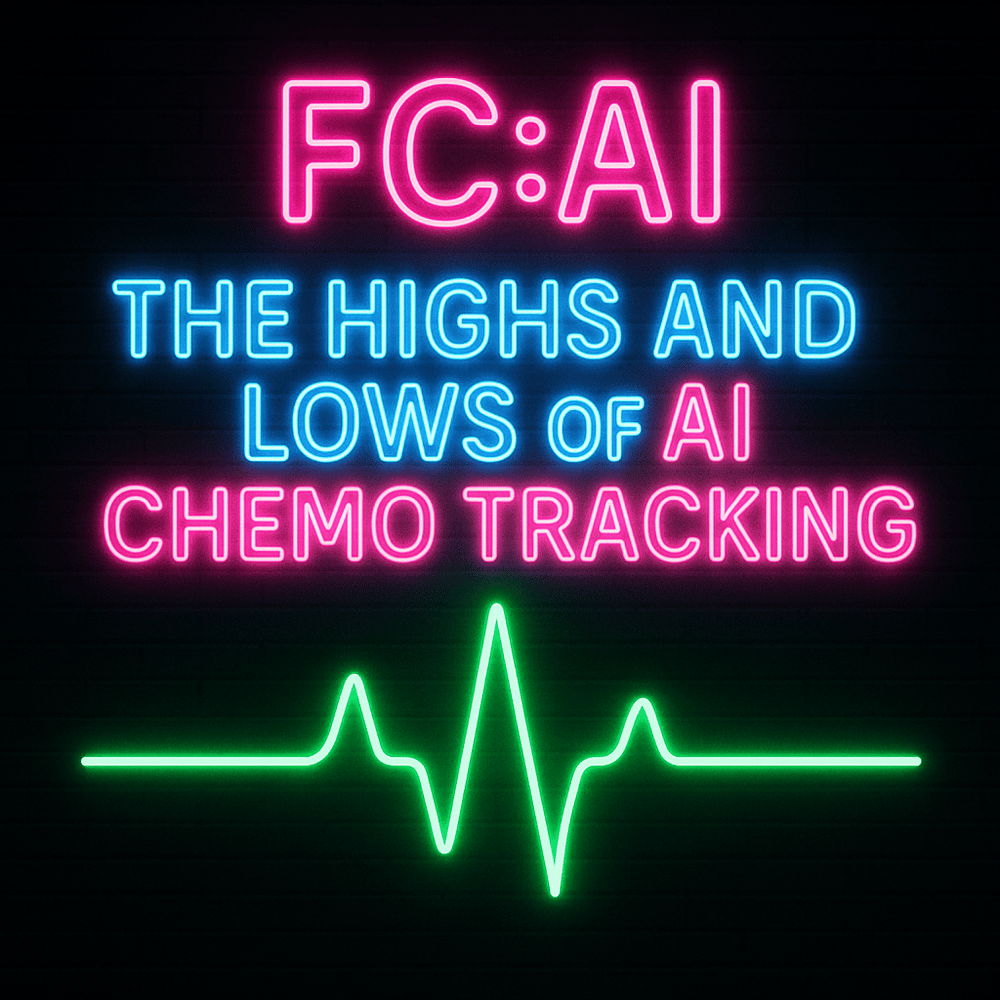FC:AI: The Process (part 2): Daily Life With AI Tracking
Blog post description.
FC:AI TOOLS AND TIPS
Russ Read-Barrow
8/7/20255 min read


(Previous post on this topic here: https://fcancerwith.ai/fcai-the-protocol-setting-up-ai-chemo-tracking-part-1 )
To be transparent upfront - AI tracking has been massively useful for me personally during chemo itself. Taking all that amazing data and using AI tools to review it and turn it in to something useful I can share has been a MASSIVE ball ache.
In short, both Manus and ChatGPT utterly forgot over 12 weeks of data and I had to export the chats manually and dump them back into Manus... which has been an pain in the arse and highlighted that neither tool is good for this long term. Their memory may still be better than my own, but not much.
But let's start from where I left off in the first blog. I did have a tracking system set up and I started recording my daily ups and downs in a structured format. It really starts to fall into place when you've got enough data to start seeing patterns. And that's when it starts to get really interesting.
This is how I went from struggling through the initial stages of chemotherapy to doing my best to optimise it. How I used what data I could gather to tackle nausea, support my sleep, and manage fatigue. It's the daily reality of living with AI tracking during cancer treatment - what actually worked, what didn't, and what I learned for next time.
Finding What Actually Worked
The Nausea Breakthrough
Nausea was the first real breakthrough, though "breakthrough" might be overstating it. With regards sickness... I didn't have my head in the toilet bowl, but it left me with this ongoing feeling of never quite knowing where I stood - some sort of grim middle ground between feeling really full or really hungry and bloated all at once. Not knowing how to sort myself out.
The nausea did have a pattern, and the data started to show me a few different things that caused the nausea to spike. What the tracking revealed was straightforward: several factors were making things worse, and addressing them systematically made a real difference.
It basically ended up encouraging me to sort my sleep out - be rigorous in terms of going to bed at the right time. I started taking domperidone every single day, without exception. Had an early dinner, took magnesium to support sleep quality.
The nausea scores did drop and eventually disappear, bar the last week of treatment (Glasto). Not because I'd discovered some revolutionary approach, but because I'd identified the specific things that were making it worse and addressed them consistently.
Sleep and the Dexamethasone Decision
One of the most valuable insights from the data was understanding how dexamethasone was affecting my sleep, and by extension, everything else. Over time, I used the tools I had to justify dropping dexamethasone gradually - and shared this data with my oncologist.
The tracking showed me that I could get away without it. I'd have a big dose with my infusion, which I couldn't avoid. But then I slowly went down from having two dex in the morning and two in the afternoon, to one, to half, and eventually to none.
It made me maybe feel a bit sicker, a bit rougher a bit earlier, but it massively helped with my sleep, which then massively helped with loads of other things. The WHOOP data was particularly useful here - I could see the direct correlation between dexamethasone doses and disrupted sleep architecture.
The Keto-ish Diet Discovery
I started a sort of keto-ish diet, which was largely dropping carbohydrates massively. Again, the tracking of that showed me that I just suffered far less digestive issues when I was ruling carbohydrates out.
At this spoint, it wasn't based on any grand theory about cancer and ketosis - it was purely practical. The data showed a clear pattern: days with higher carbohydrate intake correlated with worse digestive symptoms and general discomfort. So I adjusted accordingly.
The approach was simple: focus on protein and fats, minimize carbs, and track how I felt. The correlation was clear enough that it became an easy decision to maintain.
Exercise Timing with WHOOP
The WHOOP band especially helped me understand when I was in a good place to exercise and when I wasn't. A couple of times I went against what the recovery data was telling me, and it threw me out for days. So I just started to use it as a guide.
I started to realise that I could exercise two or three times in the week after chemo, but in the week during treatment I'd skip the gym and keep it really light - walks around the block, maybe a small ride on my exercise bike, but that was about it.
This wasn't about following some sophisticated training program. It was about having objective data that told me when pushing myself would be counterproductive. The WHOOP recovery scores became a simple go/no-go indicator for more intensive exercise.
The Daily Reality of AI-Assisted Tracking
The Learning Process
The real value wasn't in any single intervention, but in having a systematic way to test what worked and what didn't. The data provided a framework for making decisions rather than just guessing or hoping.
Some things worked better than expected - the domperidone was consistently helpful, the carbohydrate reduction had a clear impact, and the WHOOP exercise guidance prevented several potential crashes.
Other things were less clear-cut or took longer to show benefits. But having the data meant I could make informed adjustments rather than just muddling through.
The daily process became routine: check WHOOP recovery, log symptoms, note interventions, and gradually build a picture of what was helping and what wasn't. It wasn't glamorous, but it was systematic.
Tool Limitations, Not Approach Limitations
The biggest frustration was discovering the limitations of the current tools I used. Both Manus and ChatGPT lost significant amounts of tracking data, requiring manual recovery efforts that took hours.
But this highlighted something important: the limitations are with the specific AI tools I used, not with the systematic tracking approach itself. The whole process turned out to be more useful during chemo than it was afterwards, but it should give me enough to start next time with a far better understanding of how to manage.
I'll be reviewing the tools I build next time around. The approach works - systematic tracking, pattern recognition, informed adjustments - but the current AI infrastructure isn't reliable enough for long-term health data management.
Building Knowledge for Next Time
The process wasn't about discovering revolutionary approaches. It was about using available tools to identify patterns, test interventions systematically, and make informed adjustments during the daily reality of treatment.
The tracking helped, but it required enough data to start seeing meaningful patterns. And it required accepting that current AI tools have significant limitations that need to be worked around.
Most importantly, it built a foundation of knowledge about how my body responds to treatment, what interventions are worth prioritising, and what patterns to look for. That knowledge doesn't disappear when the AI tools forget the data.
The result was a more manageable treatment experience - not perfect, not miraculous, but significantly better than just hoping for the best. And crucially, it's created an approach for managing future treatment cycles more effectively from day one.
The daily process of AI-assisted tracking during chemotherapy taught me that the technology isn't magic, but systematic measurement with the right tools can provide the predictability and control needed to navigate an unpredictable process.
Next week: The Results - what three months of comprehensive tracking actually delivered, including the complete dataset analysis and honest assessment of what worked, what didn't, and what others could realistically expect.
FC:AI
© 2025 FC:AI. Built with zero bullshit during chemo.
All content © FC:AI unless otherwise credited.
